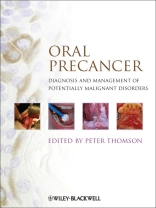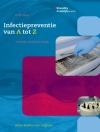Without early detection, oral cancer is deadly. Protect your patients by applying the latest clinical interventions.
Rates of new oral cancer cases continue to increase and mortality rates remain alarmingly high. Oral
cancer may be preceded by clinically identifiable precancerous changes in the oral mucosa, which offer a therapeutic window of opportunity to intervene and halt disease progression to carcinoma development.
Written and edited by prominent researchers in the field, Oral Precancer:
* Reviews current scientific research on precancer conditions of the oral cavity providing evidence-based analysis of the nature and behavior of potentially malignant and deforming oral diseases
* Explains the principles of prevention, diagnosis and management of potentially malignant disorders of the oral cavity
* Details a practical and reliable interventional treatment strategy to facilitate early diagnosis and effective treatment of both precancer and early invasive carcinoma
* Contains a chapter devoted to illustrative case histories, high-quality, color, clinical photos, reference sections in each chapter listing relevant review articles, and more
From start to finish, Oral Precancer offers undergraduate students, clinicians, and professors an invaluable resource to minimise the morbidity and mortality of this most significant and life threatening of oral conditions.
Содержание
List of Contributors
Preface
Acknowledgements
1. Introduction
General Introduction
Epidemiology
Prevention Treatment Strategies
Terminology
Summary
References
2. Structure and Function of Oral Mucosa
Introduction
Applied Anatomy of the Oral Cavity
Function of the Oral Mucosa
The Microanatomy of Oral Mucosa
Regional Variation of Oral Mucosa
Oral Epithelial Cell Kinetics
Oral Epithelial Cell Proliferative Activity
Anatomical Site Predilection for Oral Carcinogenesis
Summary
References
3. Oral Carcinogenesis
Introduction
Oral Cancer and Precancer
The ‘Progression Model’ for Oral Cancer
Aetiology and Risk Factors
Patient and Risk Factor Profiling
Summary
References
4. Clinical Presentation of Oral Precancer
Introduction
Clinical Terminology
Precancerous (Premalignant) Lesions
Precancerous (Premalignant) Conditions
Multiple Lesion Disease
Summary
References
5. Diagnostic Methods
Introduction
Screening
Clinical Examination Techniques
Vital Tissue Staining
Light Based Detection Systems
Brush Biopsy and Exfoliative Cytology
Clinical Diagnosis in Practice
Summary
References
6. Pathological Aspects of Oral Precancer
Introduction
Biopsy Techniques
The Role of the Pathologist
Histopathological Features of Oral Potentially Malignant Disorders
Grading of Dysplasia
Limitations in Conventional Pathological Techniques
Summary
References
7. Management of Oral Precancer
Introduction
Risk Factor Modification
Observation versus Intervention
Medical Treatment
Surgical Treatment
Interventional Laser Surgery
Combined Treatment Modalities
Patient Follow Up and Surveillance
Summary
References
8. Clinical Outcome
Introduction
Clinical Outcome Studies
Patient Cohort Studies
Definitions of Clinical Outcome
Newcastle Patient Cohort Studies
Patient Follow Up
Prediction of Clinical Outcome
Summary
References
9. Malignant Transformation and Oral Cancer Development
Introduction
The Risk of Progression to Oral Carcinoma
Malignant Transformation versus Oral Cancer Development
Interventional Laser Surgery and Oral Cancer Prevention
The Newcastle 10 Year Follow Up Study
High and Low Risk Patients
Clinical Signs of Oral Squamous Cell Carcinoma
Diagnosis and Management of ‘Unexpected Malignancy’
Prognosis for the ‘Transformed Patient’
Summary
References
10. The Future
Introduction
Prevention of Oral Precancer
Early Diagnosis of Potentially Malignant Disease
Interventional Management Strategies in the Future
Individualised Patient Treatments — Biomarkers and Targeted Chemoprevention
Future Research Directions
Summary
References
11. Case Histories
Introduction
Diagnosis of Unexpected Malignancy
Multiple Lesion Disease Responding to Conservative Management
Multiple Lesion Disease Requiring Repeated Laser Treatments
Proliferative Verrucous Leukoplakia
Localised Oral Lichenoid Reaction
Multiple Oral Lichenoid Reactions
Widespread Dysplastic Oral Lichenoid Reactions
An Immunosuppressed Patient
Chronic Hyperplastic Candidosis
Tobacco Associated Hyperkeratosis
Malignant Transformation in Longstanding Non-erosive Lichen Planus
Summary
12. Conclusions
Oral Cancer Potentially Malignant Disorders
Clinical Management
Patient Care Pathways
Public Health Strategies
Future Directions
Index
Об авторе
Peter Thomson is Professor of Oral and Maxillofacial Surgery at Newcastle University and
Honorary Consultant in Oral and Maxillofacial Surgery at Newcastle upon Tyne Hospitals NHS Foundation Trust. In recognition of his research into oral cancer & precancer, he has been awarded both a Hunterian Professorship from the Royal College of Surgeons of England & a King James IV Professorship from the Royal College of Surgeons in Edinburgh.












